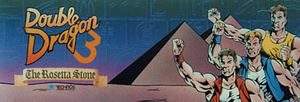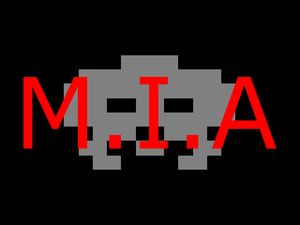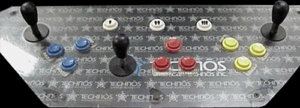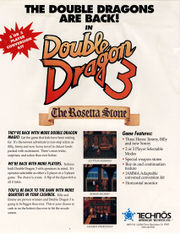Lost In Translation/Double Dragon 3 - The Rosetta Stone
| Double Dragon 3 The Rosetta Stone | |
|---|---|
| Manufacturer | Technos |
| Released | 1990 |
| Control Method |
8-way Joystick 3 Button(s) |
| Main CPU | 68000 (@ 12.000 MHz) Z80 (@ 3.580 MHz) |
| Sound CPU | Stereo YM2151 (@ 3.580 MHz) OKI6295 (@ 1.122 MHz) |
| Video Details |
Raster (Horizontal) 320 x 240 pixels 60.00 Hz 768 Palette colours |
| Screens | 1 |
| ROM Info | 30 ROMs 4,391,168 bytes (4.19 MiB) |
| MAME ID | ddragon3 · ddrago3b |
About The Game
Double Dragon 3 - The Rosetta Stone is a beat-em-up arcade video game.
A mysterious fortune teller warns Billy & Jimmy Lee about the rise of a powerful enemy in Egypt. Since the Lee brothers are looking for a true challenge to put their martial arts skills to the ultimate test, they agree to face this mysterious new enemy. They embark on a world quest - joining up with new allies in the process - and try to lay claim to the famous 'Rossetta Stone'.
The 3rd and final arcade entry of the Double Dragon series (not counting the later Neo-Geo fighting game based on the movie) features a completely new gameplay system and graphics from the first two installments. The game can played by up to 2 or 3 players, depending on the cabinet and settings. The 3rd player takes control of a yellow-clad Lee brother named Sonny, who is exclusive to this game. Techniques from the previous games such as the hair grab and the elbow punch are gone, but new ones are added such as the belly-to-back throw and the back-to-back hurricane kick, as well as the ability to dash by tapping the joystick left or right twice.
The game features weapon shops that allows the player to purchase power-ups by inserting additional tokens. The power-ups differ between stages differ between stages and are available as followed.
- Extra Guys - Allows the player to control a new character who replaces the current fighter when he dies. There are three character types in addition to the Lee brothers.
- The Urquidez brothers (Roney, Sunny, Jonny) - Tall European grapplers. They have the most energy of the four character types. Up to three fighters can be have in reserve.
- The Chin brothers (Seimei, Taimei, Sinmei) - Chubby Chinese men with powerful attacks.
- The Oyama brothers (Masao, Kunio, Akira) - Japanese karate masters dressed in gis specializing in speedy attacks.
- Tricks - The hurricane kick and the one-armed stand head butt are added to the player's move set. If the player's current character dies, then the new techniques will be inherited by the next character in reserve, if there is one.
- Weapons - A nunchaku or sword are given player. Only the Lees can have purchase and wield weapons.
- Energy - Restores the current character's life to 150%.
- Power-Up - Increases the character's agility.
There are 5 stages in the game :
- Mission 1 - America - The enemies in this stage are typical thugs and bikers. The first area takes place in a downtown area of city. After defeating the first wave of enemies, the player will enter a warehouse, where they encounter bikers that will try to run over them with their bike. The boss in this is Jim, a red-haired biker wearing a leather jacket.
- Mission 2 - China - The enemies are martial artists that specialize in flying kicks. The stage takes place in a single level set in a countryside near the Great Wall of China. The boss at the end of level is Li Cheng-Long, a Shaolin Martial Arts expert who resembles Bruce Lee. When he's down in life, he will wield out his club.
- Mission 3 - Japan - The enemies are samurai swordsmen. The first area takes place outside a castle, with bamboo traps and enemies coming out of walls. The second area takes place inside a castle, where the player will face a few more swordsmen before taking out on the boss, Ranzou, a ninja. He attacks with throwing stars and smoke bombs and splits into three forms when he's down on his life.
- Mission 4 - Italy - Consists of a single level set in the ruins of a coliseum. The enemies are roman archers. After defeating most of the archers, the boss Giuliano, a man decked in gladiator armor, will attempt to run the player over with his horse. After defeating all the archers, Giuliano will dismount at the end of the level and fight the player. He wields a long hand spear and can block attacks with his shield.
- Mission 5 - Egypt - The final stage is composed of seven levels, which includes a desert field, an underground forest, a trap room with stone pillars and giant hands emerging from the floor, a hall with a flying disc. Enemies include living tree men and rock creatures.
Trivia
Released in November 1990.
The first two Double Dragon games were created by an internal team at Technos, but this game was written by an outside team called East Technology (see Staff section for more information). A graffiti in the first stage reads "Gigandes", which one of the team's previous games.
There are 4 character types, the Lee brothers and 3 new character types (who are available via the weapon shops in the American and World versions, and are selectable in the Japanese version). However the original idea for the game was for the player to select between Billy and Jimmy Lee, or one of the 3 new characters introduced in the game. The original characters which were Roney Urquidez (who originally wore orange), Chin Seimei (who originally wore red) and Masao Oyama (who was originally named Masahiko Oyama). Apparently the designers considered the possibility that 2 or 3 players playing the game at the same time might want to control the same character, so they revised this by creating Sonny (the 3rd Lee brother) and 2 siblings for each of the new characters. A separate character portrait was made for Jimmy, which is unused in the released Japanese version. The game's ending depicts the original 5 characters, as does the artwork on the Japanese sales flyer.
Soundtrack releases :
Double Dragon 3 / The Conbatribes - Pony Canyon / Scitron - PCCB-00065 - Jun 21, 1991
Updates
The US version is slightly different, it has the 'Winners Don't Use Drugs' screen.
The Japanese version discards the weapon shops completely from the game. Instead, the game asks the player to select from the 4 character types available when they begin (Lee, Chin, Urquidez or Oyama). The one-armed stand head-butt and the hurricane kick are available as part of the default moveset, but the hurricane kick is made hard to execute. While controlling one of the Lee brothers, a nunchaku or a sword can be found on the floor in certain stages. The first stage is slightly re-arranged, with the starting point moved in front of the Power Records store and the conveyor belt inside the warehouse removed.
Series
- Double Dragon (1987)
- Double Dragon II - The Revenge (1988)
- Double Dragon 3 - The Rosetta Stone (1991)
- Super Double Dragon (1992, US/EU Nintendo Super NES) / Return of Double Dragon (1992, JP Nintendo Super Famicom)
- Battletoads & Double Dragon - The Ultimate Team (1993, Nintendo Super NES)
- Double Dragon V - The Shadow Falls (1994, Nintendo Super NES)
- Double Dragon (1995)
Staff
- Programmers
- N. Takioka
- E. Ogura
- Y. Katsumata
- Designers
- K. Ichikawa
- T. Irisawa
- T. Chida
- J. Hasepin
- H. Nagoshi
- U. Hoshino
- Audio
- A. Inoue
- T. Nozaki
Cabinet and Artwork
Ports
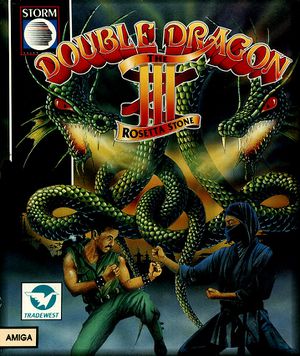
- Consoles
- Nintendo Famicom (1990)
- Sega Mega Drive (1992)
- Nintendo Game Boy
- Computers
- Commodore C64 (1991)
- PC-Compatible [MS-DOS, 5.25" / 3.5"] (1991)
- Atari ST (1991)
- Commodore Amiga (1991)
- Amstrad CPC (1991)
- Sinclair ZX Spectrum (1992)
- Others
- LCD handheld game (1991) released by Tiger Electronics
Soundtrack Releases
| Album Name | Catalogue No. | Released | Publisher | Comments |
|---|---|---|---|---|
| Double Dragon 3 / The Combatribes | PCCB-00065[1] | 1991-06-21 | Pony Canyon/Scitron | CD version. |
External Links
- Sinclair ZX Spectrum version of Double Dragon III: The Rosetta Stone at the World of Spectrum


